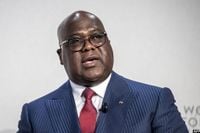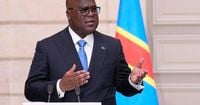In the heart of Africa, the Democratic Republic of Congo (DRC) remains mired in conflict despite a flurry of diplomatic initiatives and high-profile peace agreements. The eastern regions of this vast, mineral-rich nation have become a battleground not only for armed groups like M23 but also for the competing interests of neighboring Rwanda, global powers, and multinational corporations. The stakes couldn’t be higher: the DRC boasts over 70% of the world’s cobalt reserves, along with significant deposits of copper, lithium, tantalum, and gold—minerals vital to the global green energy transition and modern technology industries.
On June 27, 2025, hopes soared when the DRC and Rwanda inked the Critical Minerals for Security and Peace Deal in Washington, D.C., under the mediation of then-U.S. President Donald Trump. The agreement aimed to halt Rwanda’s alleged support for the M23 rebellion, open the door to Western investment in Congo’s mining sector, and establish a framework for lasting peace. Yet, just months later, fighting in eastern Congo rages on, and the humanitarian toll continues to mount. According to Reuters, President Félix Tshisekedi, speaking in New York on September 23, 2025, cast doubt on the deal’s effectiveness, warning that Congo would not “auction” its mineral wealth under foreign pressure and insisting that the nation’s sovereignty must not be compromised.
“We will be working on developing the mining value chain and infrastructure, particularly in energy,” Tshisekedi said, highlighting Congo’s openness to partnerships but drawing a firm line against external actors dictating the terms over its resources. He emphasized that while Kinshasa has already signed a strategic partnership with China and is negotiating a similar arrangement with the United States, Congo’s mineral riches are not up for grabs to the highest bidder. Chinese companies, including CMOC Group and Zijin Mining Group, currently operate some of the world’s largest cobalt and copper mines in the DRC under long-term agreements, playing a key role in the country’s exports.
The international community’s involvement in Congo’s peace process extends well beyond the United States. Earlier in 2025, Qatar brokered surprise talks between President Tshisekedi and Rwandan President Paul Kagame, briefly reviving hopes for a ceasefire. The United Arab Emirates has also played a quiet but influential role, leveraging its growing economic and security ties across Africa to mediate between the parties. These interventions underscore the global dimension of Congo’s crisis, where mineral wealth and security are deeply intertwined.
Despite these efforts, progress remains elusive. On July 19, 2025, the Congolese government and M23 signed a declaration of principles in Qatar, including a “permanent ceasefire” and commitments to prisoner exchanges. Yet, the deadline for a comprehensive peace agreement passed without resolution, and M23 has demanded the release of prisoners before further negotiations. Kinshasa, meanwhile, insists on formal agreements first. The Red Cross has been engaged to facilitate a potential prisoner swap, but as of late September, the process remains incomplete.
President Tshisekedi’s frustration boiled over at the United Nations General Assembly on September 22, where he accused Rwanda of stalling the peace deal’s implementation. “Rwanda pretends to have withdrawn its troops but in reality, Rwanda troops continue to be present on Congolese soil and to support the M23,” he told journalists, as reported by Central News. He further accused Kigali of “trying to gain time for the crisis to worsen,” but reiterated, “We, from our side, are ready to make peace.” Rwanda, for its part, denies these allegations, insisting that its actions are defensive and that M23 is a Congolese issue. The tit-for-tat accusations have only deepened the distrust.
The roots of the conflict run deep. The eastern DRC, bordering Rwanda, is home to abundant mineral resources but has suffered from violence for more than three decades. The region’s instability dates back to the aftermath of the 1994 Rwandan genocide, when Hutu militias fled into Congo, sparking wars that have killed millions. Today, over 100 armed factions operate in the area, fueling a cycle of displacement, sexual violence, and child soldier recruitment. The United Nations estimates that over 7 million people are internally displaced in the region as of mid-2025, with more than 1,000 civilian deaths attributed to M23 this year alone.
The humanitarian crisis is staggering. Camps around Goma, a vital trade hub that fell to M23 in February 2025, overflow with refugees facing cholera outbreaks and malnutrition. Women and children bear the brunt, with widespread reports of gender-based violence. The UN has documented atrocities by M23, including mass killings and forced labor. Satellite imagery and eyewitness accounts cited by Human Rights Watch in September 2025 indicate continued Rwandan military presence supporting M23, despite the peace deal. The same report revealed the expansion of a Rwandan military graveyard near the border, suggesting ongoing operations and casualties.
Meanwhile, the economic fallout is severe. The conflict disrupts mining operations, causing fluctuations in cobalt prices and impacting global markets. Illegal mineral smuggling funds armed groups, and billions in potential revenue are lost to instability. The United States, seeking to secure diversified sources of critical minerals amid competition with China, has imposed sanctions on Rwandan officials linked to M23. The European Union provides humanitarian aid but struggles with enforcement, while African Union efforts, including deployments by the East African Community, have largely failed due to accusations of bias.
South Africa’s involvement highlights the conflict’s regional implications. As part of the Southern African Development Community (SADC) mission, over 2,900 South African troops have been deployed in eastern DRC since 2023. In July 2025, two South African soldiers were killed in a mortar attack near Goma, bringing total fatalities to ten. President Cyril Ramaphosa has called for dialogue, reflecting South Africa’s longstanding commitment to peaceful resolution. South African firms, such as Anglo American, also have significant interests in DRC’s mineral sector, underlining the importance of stability for regional trade.
The United Nations peacekeeping mission, MONUSCO, faces mounting criticism for its perceived ineffectiveness. Its mandate is set to expire in December 2025, amid calls for withdrawal and questions about the international community’s commitment to protecting civilians. As fighting continues and peace deals falter, the risk grows that Congo’s resource wealth will remain a curse, fueling instability rather than development.
For millions in eastern DRC, the hope is that international pressure and genuine commitment from all parties will finally bring an end to decades of suffering. Yet, as competing interests and deep-seated distrust persist, the path to peace remains as treacherous as ever.


